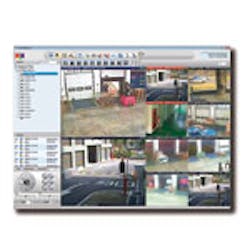What’s an NVR? How does it differ from a DVR? Does a DVR that can handle both analog and digital signals move into the realm of the NVR? If you’re a systems integrator, you may be asking these same questions when you go to specify the recording medium for a customer’s surveillance system at the protected premises.
“What the heck is the difference between a DVR and an NVR?” chided Jim Kauker, executive vice president of Sales and Marketing for NAVCO Networks and Security, Anaheim, Calif., to SD&I during a discussion on the topic, admitting that there is widespread confusion on product terminology.
“A DVR can reside on the network and the NVR is also on the network and neither cares if it’s an analog or digital camera signal,” he said. “Quite frankly, the end-user doesn’t care. When they want pictures, they want pictures, so you have to figure out the best solution to do that.” For those larger camera systems, NAVCO prefers to build a separate network for customers lessening any objections from IT personnel about putting a piece of hardware—network video recorders--on their network infrastructure. Kauker predicted that in about five years most video storage will be at the edge in SD cards at the cameras.
Up in the air
The video surveillance recording market is definitely in transition. Now that both analog and digital signals can be transferred to DVRs or NVRs and DVRs have become more feature rich, adding capabilities such as point of sale, H.264 video codec, on-board monitors, 1080p, GUI menus, hard drive expansion capability, mobile monitoring, iPhone integration, USB backup, standalone or network connectivity and more--the product category is literally stepping into NVR terrain. And it could be all this cross-migration of technological specs/functions formerly reserved for the NVR that is adding to the confusion.
“It used to be pretty simple that a DVR was just tied to a specific analog camera,” said Lee Caswell, founder and chief marketing officer, Pivot3, Palo Alto, Calif. “The hybrid products now blur the lines a lot. I think of an NVR as something that can be shared by many cameras and users and can be on a distributed or centralized environment. I think that you’re absolutely seeing folks that build DVRs moving to higher quality, server-based products—that’s happening across the board. People are relying on the surveillance data now more than they were in the past and the expectations have ratcheted up.”
According to Greig Silver, senior integration engineer at IDESCO Corp., New York City, a lot of what the integrator specifies will depend on the sophistication of the customer and how strong and open their IT folks are to using an NVR. “Of course the initial struggle was to get the IT folks to let us on the network but now with compression rate H.264 some of the bandwidth concerns have been addressed,” Silver said. “The choice of whether or not to use an NVR is dependent on the sophistication of the customer’s IT personnel, because they ultimately will be managing the product.”
Silver also added that NVRs are more feature rich because they leverage the network. “An NVR is a great way to manage video day to day and it’s so far ahead of a DVR,” Silver said. “When you have networking experience, putting the camera and NVR on the network is so intuitive. If a camera goes out, you get an e-mail alert, so there are supervisory capabilities. In addition, with an NVR your ability to expand is virtually endless. NVRs are more expensive the same way a good quality DVR was back in the day. Today, a 4TB NVR costs the same money that a DVR did in the past.”
He added that for systems under 20 cameras, an NVR might not be cost-justified. “For over 22 cameras, the entire system (with UTP cabling) and cost of ownership is actually less. NVRs make it easier to integrate with access control on the network and move the customer to video analytics when they are ready. We will still use DVRs for smaller installations, like those with four to 16 cameras and installs with budget constraints,” Silver continued.
Caswell said that currently in the market enterprise quality is more important and that’s what users are demanding.
“So the expectations are higher and as a result, suppliers of standalone DVR products are now introducing server-class motherboards. They’re introducing Redundant Array of Independent Disks (RAID) systems, either within the box, which is what you need in a distributed environment or as a centralized storage and enterprise feature, like failover for the applications. Those are becoming the standard within any of the higher-end systems.”
When it comes to the reliability of a product, whether a DVR or NVR, the questions seem simple, according to Caswell. What happens if the recording station itself fails? Do I care enough to make sure if the recording continues on? “And if you can answer those questions, then you have an idea of whether you have an enterprise solution or just a standalone, check-the-box solution.”
Manufacturers in the NVR and DVR communities owe it to security resellers to make sure they are clear on what their systems can and cannot do and how they fit into the convergence space. If reseller’s can’t install a product without a major headache and roadbumps along the way, they won’t use it. These product categories are still currently viable, but the future is unclear. With everything moving to virtualization and hosted services, both these categories won’t be around forever, so it’s going to take some spot-on thinking by manufacturers to save these products and present migration strategies everyone can live with in the interim.
NVR Roundup
Sidebar: IMS beacon on NVRs
SD&I magazine recently discussed the state of network video recorders (NVRs) with IMS Research Analyst Gary Wong, Wellingborough, England.
SD&I: Where do you see the market for NVRs headed?
Wong: In a global sense we see the market continuing to grow rapidly for hardware NVRs. However it is growing quicker in some regions than in others. For example, in Asia there is a greater affinity for hardware NVRs than in North America or Western Europe.
SD&I: IMS recently released their “10 for 2010” report on upcoming trends in video surveillance, in which you predicted that network camera prices will drop in 2010 and video management software will evolve in 2010. How will that affect the growth of NVRs?
Wong: The growth of VMS will not necessarily impact the growth of hardware NVRs. While there is preference for VMS rather than hardware NVR solutions in the U.S. and Western Europe, we see both forms of recording continuing to grow strongly over the next three to four years. The adoption of VMS is partly project driven. At the lower end of the market, if you are only talking about a 16-camera project, it makes sense to have a hardware-embedded device but if you’re talking about projects of 100+ cameras, it generally makes more sense to switch to the software solution.
SD&I: In what areas, DVRs, NVRs or VMS, can we expect to see the most growth for 2010 and beyond?
Wong: At the enterprise level, we see enterprise DVR growth dropping off over the next few years and as enterprise systems transition towards IP, NVR and VMS adoption will increase. In a global sense, we see DVR growth slowing over the next five years and VMS growth strengthening.
SD&I: In 2007, IMS released a report predicting that by 2010, the combined market for network cameras, video servers and NVRs was forecast to exceed $2.6 billion. Have you found that we have met that predicted forecast?
Wong: Unfortunately that forecast has not held true. When the forecast was initially released in 2007, it underestimated the severity of the economic downturn and as a result, we haven’t really seen the $2.6 billion target. We estimate that network video surveillance sales in 2010 will be around the $2 billion mark.
About the Author








.jpg?auto=format,compress&fit=max&q=45?w=250&width=250)




